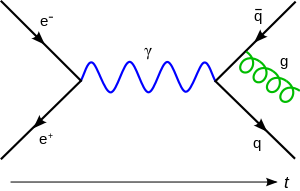Wick's theorem
| Quantum field theory |
|---|
| History |
|
Incomplete theories |
|
Scientists
|
Wick's theorem is a method of reducing high-order derivatives to a combinatorics problem.[1] It is named after Gian-Carlo Wick. It is used extensively in quantum field theory to reduce arbitrary products of creation and annihilation operators to sums of products of pairs of these operators. This allows for the use of Green's function methods, and consequently the use of Feynman diagrams in the field under study. A more general idea in probability theory is Isserlis’ theorem.
Definition of contraction
For two operators and we define their contraction to be
where denotes the normal order of an operator .
Alternatively, contractions can be denoted by a line joining and .
We shall look in detail at four special cases where and are equal to creation and annihilation operators. For particles we'll denote the creation operators by and the annihilation operators by (). They satisfy the usual commutation relations , where denotes the Kronecker delta.
We then have
where .
These relationships hold true for bosonic operators or fermionic operators because of the way normal ordering is defined.
Examples
We can use contractions and normal ordering to express any product of creation and annihilation operators as a sum of normal ordered terms. This is the basis of Wick's theorem. Before stating the theorem fully we shall look at some examples.
Suppose and are bosonic operators satisfying the commutation relations:
where , denotes the commutator, and is the Kronecker delta.
We can use these relations, and the above definition of contraction, to express products of and in other ways.
Example 1
Note that we have not changed but merely re-expressed it in another form as
Example 2
Example 3
In the last line we have used different numbers of symbols to denote different contractions. By repeatedly applying the commutation relations it takes a lot of work, as you can see, to express in the form of a sum of normally ordered products. It is an even lengthier calculation for more complicated products.
Luckily Wick's theorem provides a shortcut.
Statement of the theorem
A product of creation and annihilation operators can be expressed as
In other words, a string of creation and annihilation operators can be rewritten as the normal-ordered product of the string, plus the normal-ordered product after all single contractions among operator pairs, plus all double contractions, etc., plus all full contractions.
Applying the theorem to the above examples provides a much quicker method to arrive at the final expressions.
A warning: In terms on the right hand side containing multiple contractions care must be taken when the operators are fermionic. In this case an appropriate minus sign must be introduced according to the following rule: rearrange the operators (introducing minus signs whenever the order of two fermionic operators is swapped) to ensure the contracted terms are adjacent in the string. The contraction can then be applied (See Rule C″ in Wick's paper).
Example:
If we have two fermions () with creation and annihilation operators and () then
Note that the term with contractions of the two creation operators and of the two annihilation operators is not included because their contractions vanish.
Wick's theorem applied to fields
The correlation function that appears in quantum field theory can be expressed by a contraction on the field operators:
where the operator are the amount that do not annihilates the vacuum state . Which means that . This means that is a contraction over . Note that the contraction of a time-ordered string of two field operators is a c-number.
In the end, we arrive at Wick's theorem:
The T-product of a time-ordered free fields string can be expressed in the following manner:
Applying this theorem to S-matrix elements, we discover that normal-ordered terms acting on vacuum state give a null contribution to the sum. We conclude that m is even and only completely contracted terms remain.
where p is the number of interaction fields (or, equivalently, the number of interacting particles) and n is the development order (or the number of vertices of interaction). For example, if
This is analogous to the corresponding theorem in statistics for the moments of a Gaussian distribution.
Note that this discussion is in terms of the usual definition of normal ordering which is appropriate for the vacuum expectation values (VEV's) of fields. (Wick's theorem provides as a way of expressing VEV's of n fields in terms of VEV's of two fields.[2]) There are any other possible definitions of normal ordering, and Wick's theorem is valid irrespective. However Wick's theorem only simplifies computations if the definition of normal ordering used is changed to match the type of expectation value wanted. That is we always want the expectation value of the normal ordered product to be zero. For instance in thermal field theory a different type of expectation value, a thermal trace over the density matrix, requires a different definition of normal ordering.[3]
See also
References
- ↑ Philips, 2001
- ↑ See for example also: Mrinal Dasgupta: An introduction to Quantum Field Theory, Lectures presented at the RAL School for High Energy Physics, Somerville College, Oxford, September 2008, section 5.1 Wick's Theorem (downloaded 3 December 2012)
- ↑ (Evans and Steer, 1996)
- G.C. Wick, The Evaluation of the Collision Matrix, Phys. Rev. 80, 268 - 272 (1950)
- Silvan S. Schweber, An Introduction to Relativistic Quantum Field Theory, Harper and Row, New York (1962). (Chapter 13, Sec c)
- M. E. Peskin and D. V. Schroeder, An Introduction to Quantum Field Theory, Perseus Books (1995). (§4.3)
- Tony Philips (November 2001). "Finite-dimensional Feynman Diagrams". What's New In Math. American Mathematical Society. Retrieved 2007-10-23.
- T.S. Evans, D.A. Steer, Wick's theorem at finite temperature, Nucl. Phys B 474, 481-496 (1996) arXiv:hep-ph/9601268
